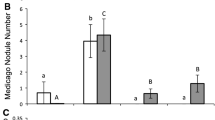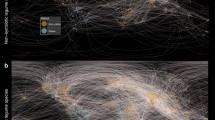Abstract
The availability and quality of mutualists beyond a species’ range edge may limit range expansion. With the legume Chamaecrista fasciculata, we asked to what extent the availability and quality of rhizobia beyond the range edge limits host range expansion. We tested the effect of rhizobia availability on plant growth by transplanting seed from three locations into five sites spanning C. fasciculata’s range (interior, at the northern and western range edges, and beyond the range edges), and inoculating half the seeds with rhizobia. We recorded growth of all surviving plants, and, for the uninoculated plants, whether they had formed nodules or not. We isolated rhizobia from nodules collected on the uninoculated plants, and cross-inoculated seed from four populations (both range edge and interior populations) in the greenhouse to determine whether the quality of rhizobia differed between regions. We found that seeds transplanted beyond the range edge were less likely to be nodulated when they were not experimentally inoculated, and there was benefit to inoculation at all sites. In the greenhouse, the three inocula that formed nodules on plants, from the range interior, northern edge and beyond the northern edge, did not detectably differ in their effect on plant growth. These results suggest that low densities of suitable rhizobia beyond the range edge may limit range expansion of legume species.


Similar content being viewed by others
References
Ackerly DD (2003) Community assembly, niche conservatism, and adaptive evolution in changing environments. Int J Plant Sci 164(3 Supp):S165–S184
Angert A, Schemske D (2005) The evolution of species’ distributions: reciprocal transplants across the elevation ranges of Mimulus cardinalis and M. lewisii. Evolution 59:1671–1684
Antonovics J (2009) The effect of sterilizing diseases on host abundance and distribution along environmental gradients. Proc R Soc Lond B 276:1443–1448
Béna G, Lyet A, Huguet T, Olivieri I (2005) Medicago–Sinorhizobium symbiotic specificity evolution and the geographic expansion of Medicago. J Evol Biol 18:1547–1558
Burdon J, Gibson A, Searle S, Woods M, Brockwell J (1999) Variation in the effectiveness of symbiotic associations between native rhizobia and temperate Australian Acacia: within-species interactions. J Appl Ecol 36:398–408
Bushnell O, Sarles W (1937) Studies on the root-nodule bacteria of wild leguminous plants in Wisconsin. Soil Sci 44:409–423
Case T, Taper M (2000) Interspecific competition, environmental gradients, gene flow, and the coevolution of species’ borders. Am Nat 155:583–605
Case T, Holt RD, McPeek M, Keitt TH (2005) The community context of species’ borders: ecological and evolutionary perspectives. Oikos 108:28–46
Davis MB, Shaw RG (2001) Range shifts and adaptive responses to quaternary climate change. Science 292:673–679
Doyle JJ, Luckow MA (2003) The rest of the iceberg. Legume diversity and evolution in a phylogenetic context. Plant Physiol 131:900–910
Geber MA, Eckhart VM (2005) Experimental studies of adaptation in Clarkia xantiana. II. Fitness variation across a subspecies border. Evolution 59:521–531
Heath KD (2010) Intergenomic epistasis and coevolutionary constraint in plants and rhizobia. Evolution 64:1446–1458
Heath KD, Tiffin P (2007) Context dependence in the coevolution of plant and rhizobial mutualists. Proc R Soc Lond B 269:1905–1912
Holt RD, Barfield M (2009) Trophic interactions and range limits: the diverse roles of predation. Proc R Soc Lond B 276:1435–1442
Irwin HS, Barneby RC (1982) The American Cassiinae. A synoptical revision of the Leguminosae tribe Cassieae subtribe Cassiinae in the New World. New York Botanical Garden Press, New York
Milliken GA, Johnson DE (2009) Analysis of messy data, vol 1. Designed experiments, 2nd edn. CRC Press, New York
Morris W et al (2007) Direct and interactive effects of enemies and mutualists on plant performance: a meta-analysis. Ecology 88:1021–1029
Naisbitt T, Sprent JI (1993) The long-term effects of nitrate on the growth and nodule structure of the caesalpinioid herbaceous legume Chamaecrista fasciculata Michaux. J Exp Bot 44:829–836
Nuñez MA, Horton TR, Simberloff D (2009) Lack of belowground mutualisms hinders Pinaceae invasions. Ecology 90:2352–2359
Parker MA (2001) Mutualism as a constraint on invasion success for legumes and rhizobia. Divers Dist 7:125–136
Parker MA, Kennedy DA (2006) Diversity and relationships of Bradyrhizobia from legumes native to eastern North America. Can J Microbiol 52:1148–1157
Parker MA, Malek W, Parker IM (2006) Growth of an invasive legume is symbiont limited in newly occupied habitats. Divers Dist 12:563–571
Price TD, Kirkpatrick M (2009) Evolutionarily stable range limits set by interspecific competition. Proc R Soc Lond B 276:1429
Pringle A, Bever JD, Gardes M, Parrent JL, Rillig MC, Klironomos JN (2009) Mycorrhizal symbioses and plant invasions. Annu Rev Ecol Evol Syst 40:699–715
Purves DW (2009) The demography of range boundaries versus range cores in eastern US tree species. Proc R Soc Lond B 276:1477–1484
R Development Core Team (2009) R: a language and environment for statistical computing. R Foundation for Statistical Computing, Vienna
Ratcliff WC, Kadam SV, Denison RF (2008) Poly-3-hydroxybutyrate (PHB) supports survival and reproduction in starving rhizobia. FEMS Microbiol Ecol 65:391–399
Rehfeldt G, Ferguson D, Crookston N (2008) Quantifying the abundance of co-occurring conifers along inland northwest (USA) climate gradients. Ecology 89:2127–2139
Sagarin RD, Gaines SD (2002) The ‘abundant centre’ distribution: to what extent is it a biogeographical rule? Ecol Lett 5:137–147
Somasegaran P, Hoben HJ (1994) Handbook for rhizobia: methods in legume—Rhizobium technology. Springer, Heidelberg
Spoerke JM, Wilkinson HH, Parker MA (1996) Nonrandome genotypic associations in a legume—Bradyrhizobium mutualism. Evolution 50:146–154
Tlusty B, Grossman JM, Graham PH (2004) Selection of rhizobia for prairie legumes used in restoration and reconstruction programs in Minnesota. Can J Microbiol 50:977–983
Acknowledgments
We thank Peter Tiffin, William Ratcliff and Ruth Shaw for helpful discussion and comments, Larissa Mottl at Conard Environmental Research Area, Jean Knops at University of Nebraska, Shawn Schottler at St. Croix Watershed Research Area, Bryan Wood at the Audubon Center of the Northwoods for the use of field sites, and Konza Prairie, Tyson Research Station, Conard Environmental Research Area and the Minnesota Department of Natural Resources for seed collection, and two anonymous reviewers for helpful comments. This work was funded by a University of Minnesota Undergraduate Research Opportunity Fellowship to C.A., the Center of Community Genetics Fellowship to J.S.-G. and National Science Foundation DEB 0515466 to Peter Tiffin. All work performed in this study complies with laws of the United States of America. Data accessibility: DRYAD entry: doi:10.5061/dryad.8566.
Author information
Authors and Affiliations
Corresponding author
Electronic supplementary material
Below is the link to the electronic supplementary material.
Rights and permissions
About this article
Cite this article
Stanton-Geddes, J., Anderson, C.G. Does a facultative mutualism limit species range expansion?. Oecologia 167, 149–155 (2011). https://doi.org/10.1007/s00442-011-1958-4
Received:
Accepted:
Published:
Issue Date:
DOI: https://doi.org/10.1007/s00442-011-1958-4




